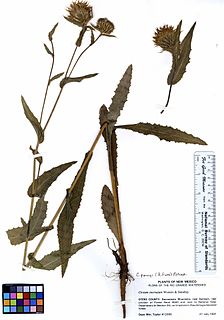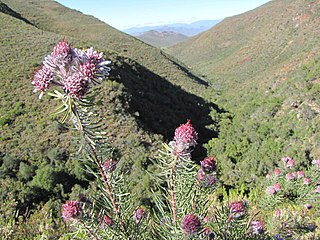
Zinnia acerosa is a low-growing perennial flowering plant native to the Southwestern United States and Northern Mexico. Common names include desert zinnia, wild zinnia, white zinnia, and spinyleaf zinnia. It is a popular landscape plant in the southwest due to its low water use and long bloom period. The flowers also serve as a food source for southwestern butterflies.

Geranium viscosissimum, commonly known as the sticky purple geranium, is a perennial in the flowering plant family Geraniaceae. It is thought to be a protocarnivorous plant.

Cirsium cymosum is a North American species of thistle known by the common name peregrine thistle. It is native to the western United States, where it has been found in California, Oregon, Nevada, Utah, Idaho, Wyoming, and Montana.

Cirsium parryi, or Parry's thistle, is a species of North American flowering plants in the aster family. It is native to the southwestern United States, where it has been found in Colorado, Arizona, and New Mexico.

The flora of the U.S. Sierra Nevada alpine zone is characterized by small, low growing, cushion and mat forming plants that can survive the harsh conditions in the high-altitude alpine zone above the timber line. These flora often occur in alpine fell-fields. The Sierra Nevada alpine zone lacks a dominant plant species that characterizes it, so may or may not be called a vegetation type. But it is found above the subalpine forest, which is the highest in a succession of recognized vegetation types at increasing elevations.
Aristolochia watsonii is a perennial plant in the birthwort family (Aristolochiaceae), found growing among plants of the Arizona Uplands in the Sonoran Desert. The plant is inconspicuous, small and hard to spot, but can be found by following the pipevine swallowtail which lays eggs on it.

Gaillardia pinnatifida, the Hopi blanketflower or red dome blanketflower, is a perennial plant in the sunflower family (Asteraceae) found in northern Mexico and in the south-central and southwestern United States.
Astragalus flavus is a perennial plant in the legume family (Fabaceae) found in the Colorado Plateau and Canyonlands region of the southwestern United States.
Asclepias macrosperma is a perennial plant in the family Apocynaceae found in the Colorado Plateau and Canyonlands region of the southwestern United States.
Quercus welshii, the wavy leaf oak, shinnery oak, or Tucker oak, is a North American species of shrub in the found in the Colorado Plateau and Canyonlands region of the southwestern United States.
Platanthera zothecina is a perennial plant in the orchid family (Orchidaceae) found in the Colorado Plateau and Canyonlands region of the southwestern United States.

Lupinus pusillus, the rusty lupine or dwarf lupine, is an annual plant in the legume family (fabaceae) found in the Colorado Plateau and Canyonlands region of the southwestern United States, and north to Montana.
Sophora stenophylla, the fringeleaf necklacepod, or silvery sophora, is a perennial plant in the legume family (Fabaceae) found in the Colorado Plateau and Canyonlands region of the southwestern United States.

Penstemon comarrhenus is a perennial plant in the plantain family (Plantaginaceae) found in the Colorado Plateau and Canyonlands region of the southwestern United States.

Penstemon cyanocaulis, the bluestem penstemon or bluestem beardtongue, is a perennial plant in the plantain family (Plantaginaceae) found in the Colorado Plateau and Canyonlands region of the southwestern United States.
Primula specuicola is perennial plant in the primrose family (Primulaceae) found in the Colorado Plateau and Canyonlands region of the southwestern United States.

Astragalus preussii is an annual or perennial plant in the legume family (Fabaceae) found in the Colorado Plateau and Canyonlands region of the southwestern United States.

Astragalus mollissimus is a perennial plant in the legume family (Fabaceae) found in the Colorado Plateau and Canyonlands region of the southwestern United States.

Astragalus desperatus is a perennial plant in the legume family (Fabaceae) found in the Colorado Plateau and Canyonlands region of the southwestern United States.

Vexatorella latebrosa, also known as the Robertson vexator, is an evergreen, upright shrub of up to about 1½ m high, from the family Proteaceae. It has entire, long inverted egg-shaped, bluish grey, leathery leaves that are line-shaped to very narrowly spade-shaped in outline, 5–6½ cm (2.0–2.6 in) long and 2–3 mm (0.08–0.12 in), and mostly solitary globular flower heads at the end of the branches of 2½–3 cm (0.8 in) across with scented, pink to carmine flowers with extended, styles with a thickened tip. The plants are flowering from August to September. It is an endemic species that is restricted to the Western Cape province of South Africa.












